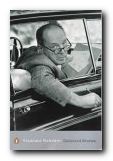a critical examination of Nabokov’s collected stories
In this story Nabokov took what looks, in relation to his work as a whole, like a false move – a backwards step into the realms of fantasy. He himself rated it lowly – ‘A rather artificial affair…with more concern for the tricky plot than for imagery and good taste’ (TD,p.40) – and it was a genre he never used again.
 ‘A Nursery Tale’ (June 1926) features the devil visiting Berlin in the form of a middle-aged woman. She makes a pact with Erwin, a young office worker who is full of frustrated sexual longings. He can have as many women as he chooses at midnight of the following day – on the one condition that the total is an odd number. Erwin is greedy and selects thirteen by the appointed hour, only to discover that the last girl he chooses is the same girl as the first. He forfeits his chance and goes home depressed.
‘A Nursery Tale’ (June 1926) features the devil visiting Berlin in the form of a middle-aged woman. She makes a pact with Erwin, a young office worker who is full of frustrated sexual longings. He can have as many women as he chooses at midnight of the following day – on the one condition that the total is an odd number. Erwin is greedy and selects thirteen by the appointed hour, only to discover that the last girl he chooses is the same girl as the first. He forfeits his chance and goes home depressed.
The story harks back through Gogol to E.T.A.Hoffmann, a source which Nabokov acknowledges by having his devil, Frau Monde, living at number thirteen Hoffmann Street. But despite the skills which Nabokov would later develop at moving credibly between various levels of fictionality, he seems ill at ease here. He fails to make his devil or the fantasy convincing.
Apart from dealing with a topic (frustrated sexuality) he would later make famous for himself, the story lacks any serious thematic concern. And even though the story has been ‘revamped’ (TD,p.40) the thinness of the material leaves exposed some of Nabokov’s potentially irritating mannerisms, such as his tendency towards excessive alliteration: “pedalling with passionate power” (p.53) and “the lustrous leaves of the lindens” (p.47).
The story does however possess one feature which is of interest in tracing the development of Nabokov’s literary style – this is the placing of subtle hints and clues within the narrative which have the ostensible purpose of signals from Frau Monde to let Erwin know that she has recognised his choice – “I shall have a sign given you [sic] every time – a smile…a chance word in the crowd, a sudden patch of colour” (p.46). These are not unlike the clues which Nabokov sprinkles in his own work as signals to his readers.
Given the centrality of Lolita in Nabokov’s work, this story is mainly of interest for the early appearance of a Humbert-like figure who strolls through the later pages with a nymphet at his side: ‘He was a famous poet, a senile swan…[who] strode with a kind of ponderous grace; his hair, the hue of soiled cottonwool, reached over his ears beneath his fedora’ (p.54).
But even more important is the fact that Erwin’s choice of girl turns out to be the precursor of many Lolita-like figures to come in Nabokov’s work. She is described as ‘a child [my emphasis] of fourteen or so in a low-cut party dress … mincing at the old poet’s side … her lips were touched up with rouge. She walked swinging her hips very, very slightly’.
Figures such as these, as well as the whole of his later novella The Enchanter undermine the notion that the inspiration for Lolita was anything like the chimpanzee behind bars in the Jardin des Plantes which Nabokov claimed. Middle-aged pedophilia is alive and well in his work long before that excuse was offered to – and swallowed by – a gullible public.
© Roy Johnson 2005
![]() Vladimir Nabokov: The Collected Stories – Amazon UK
Vladimir Nabokov: The Collected Stories – Amazon UK
![]() Vladimir Nabokov: The Collected Stories – Amazon US
Vladimir Nabokov: The Collected Stories – Amazon US
Vladimir Nabokov web links
Vladimir Nabokov greatest works
Vladimir Nabokov criticism
Vladimir Nabokov life and works